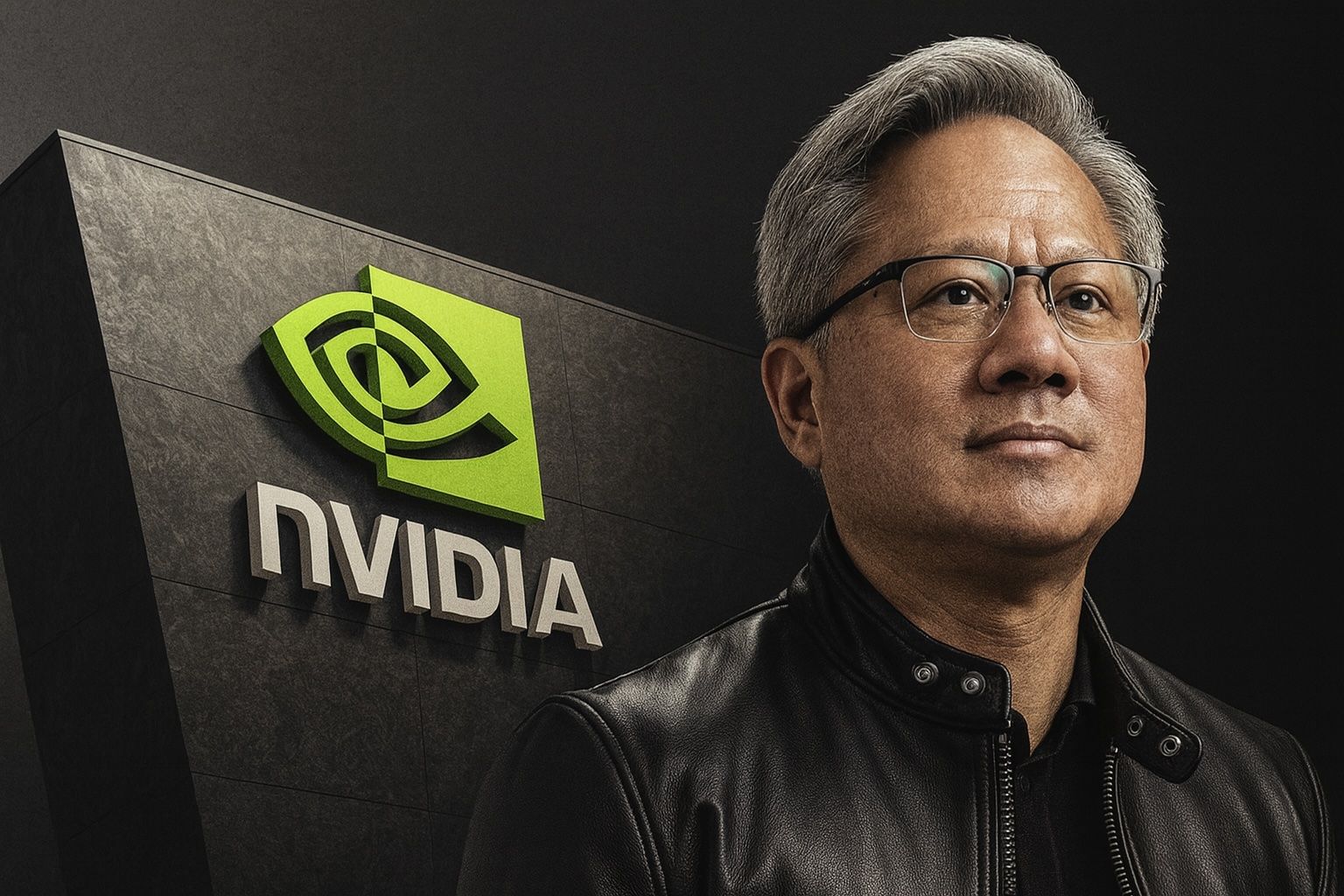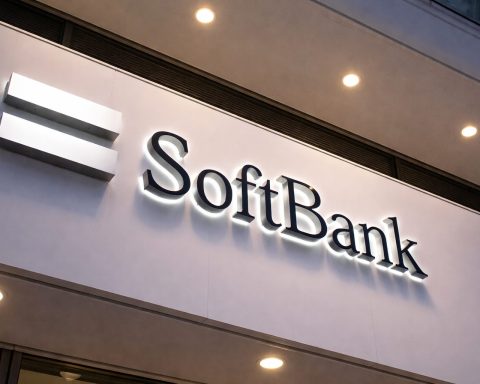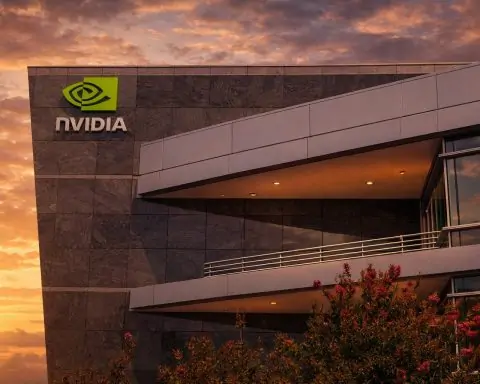- NVDA near record highs: Nvidia’s stock is trading around $182 per share as of Friday’s close, not far from its all-time peak (~$195) reached earlier this month [1]. Shares dipped mid-October on profit-taking and macro jitters, but quickly rebounded, showcasing resilience.
- AI boom = explosive growth: Insatiable demand for Nvidia’s AI chips drove a 56% revenue surge last quarter to $46.7 billion [2]. Data-center sales alone hit $41 billion, boosting Nvidia’s market capitalization above $4.4 trillion – briefly making it the world’s most valuable company [3].
- Competition & risks: Rival chipmaker AMD has scored big wins – including a landmark OpenAI chip deal and Oracle’s plan to use AMD’s upcoming AI GPUs – stoking future competition [4]. Meanwhile, U.S.–China trade tensions and export curbs on advanced chips cloud ~10–15% of Nvidia’s revenue that comes from China [5].
- Wall Street bullish: Despite Nvidia’s lofty valuation, most analysts remain upbeat. 38 of 47 analysts rate NVDA a “Buy,” with average price targets around $210–$220 (~15% above current levels) [6]. The company reports earnings on Nov. 19, and another blockbuster quarter is widely anticipated as AI demand stays red-hot [7].
- Securing supply & capacity: Nvidia is bolstering its production pipeline – on Friday it unveiled the first U.S.-made test wafer of its next-gen “Blackwell” AI chips, produced with TSMC in Arizona [8]. Nvidia is also part of a group acquiring Aligned Data Centers for $40 billion to lock in infrastructure for AI computing needs [9].
- Global outlook: CEO Jensen Huang will meet with industry leaders at the APEC summit in late October, as Washington and Beijing prepare high-level talks [10]. Any breakthrough in U.S.-China trade negotiations – such as easing chip export restrictions – could remove a major overhang on Nvidia’s future sales [11].
NVDA Stock Volatility Near Highs
Nvidia’s stock (NASDAQ: NVDA) has been on a rollercoaster this month, yet remains near record levels. In early October, NVDA surged to an all-time high around $195.62, fueled by frenzied buying amid the AI hype [12]. But by mid-month, a sharp pullback hit – the stock tumbled over 4% in one session (Oct. 14) down to roughly $180 [13] as traders took profits and broader tech sentiment soured. This volatility coincided with macro jitters: rising bond yields and strong bank earnings triggered a rotation out of pricey tech shares [14]. High-valuation names like Nvidia (around 50× earnings multiple) proved especially sensitive to these swings [15].
Even so, dip buyers quickly stepped in. By the end of last week, NVDA bounced back to the low-$180s [16]. The stock is still up about 58% year-over-year, underscoring its status as the market’s premier “AI play” [17]. Major indexes also stabilized late in the week – for instance, the S&P 500 and Nasdaq posted modest gains on Friday – suggesting investors remain willing to hold tech winners despite recent tremors. As trading gears up on Monday, Nvidia’s proximity to its peak keeps it squarely in the spotlight.
AI Boom Fuels Record Sales and Value
Nvidia’s fundamentals are living up to the AI hype. In its most recent quarter (FY2026 Q2, covering May–July 2025), revenue jumped 56% year-on-year to $46.7 billion, blowing past expectations [18]. Astonishingly, about 88% of those sales ($41.1 billion) came from data-center products – chiefly the GPUs powering generative AI models [19]. This growth is unprecedented for a company of Nvidia’s size. Profitability is soaring as well: gross margins top 72%, with net margins over 50%, reflecting huge economies of scale amid the AI chip feeding frenzy [20] [21].
Investors have rewarded Nvidia by bidding its market capitalization into the stratosphere. In early October, Nvidia’s market cap briefly exceeded $4.5 trillion, vaulting it past every other company on the planet [22]. At roughly $4.4 trillion today, Nvidia is worth more than 10× AMD (~$350 B) and 30× Intel (~$150 B) combined [23]. Such a lofty valuation (around 53× trailing earnings, ~33× forward) far outpaces the semiconductor industry average [24]. That gap has sparked debate over how much “AI premium” is already priced in [25]. Skeptics warn that Nvidia must keep delivering stunning growth to justify these levels – any stumble could spur a sharp correction.
So far, Nvidia continues to fire on all cylinders. It has launched new products at a breakneck pace, reinforcing its dominance in AI hardware. Recently the company rolled out its GeForce RTX 50-series GPUs with AI-enhanced gaming performance, and began shipping DGX Spark, touted as the world’s smallest AI supercomputer [26]. Nvidia is also investing in future capacity: it unveiled plans for next-generation “AI factories” – essentially gigantic data centers with cutting-edge power infrastructure to train future AI models [27]. In fact, one smaller supplier’s stock surged 27% after Nvidia chose its advanced power chips for these systems [28]. The broader industry is booming too – Taiwan’s TSMC just raised its sales forecast and posted record profits on soaring AI chip demand, a tide lifting all chip boats [29] [30]. In short, Nvidia’s real-world results and initiatives are underpinning its astronomical valuation – even if some AI optimism is arguably baked in.
Rising Competition and Geopolitical Risks
Nvidia’s undisputed lead in AI chips is now attracting serious challengers. Advanced Micro Devices (AMD), long a smaller rival, has made headline-grabbing moves to muscle into the AI arena. Earlier this month AMD struck a blockbuster deal to supply AI chips to OpenAI, the maker of ChatGPT [31]. OpenAI will reportedly buy up to 6 gigawatts of AMD’s upcoming MI450 GPUs (a huge order that even includes an option for OpenAI to take a stake in AMD) [32]. And in a related win, Oracle announced it will deploy 50,000 of AMD’s MI450 chips in its cloud data centers starting in 2026 [33] [34] – a big vote of confidence in AMD’s technology. These developments won’t dent Nvidia’s dominance overnight (Nvidia’s H100 GPUs remain the industry’s gold standard). However, they signal that competition is heating up, and some customers are looking for alternatives. Nvidia itself has started selling full server systems (“AI superclusters”) with its own CPUs and GPUs bundled [35], as rivals like AMD race to follow suit. The AI chip market of the late 2020s could become more crowded, which may eventually pressure Nvidia’s pricing power or market share.
Another major risk comes from geopolitics. About 10–15% of Nvidia’s revenue comes from China [36], a huge market for AI and cloud computing. But U.S.–China tensions threaten to cut off some of that business. Over the past year, U.S. regulators have imposed export controls barring Nvidia from selling its most advanced GPUs to China, aiming to limit China’s AI capabilities [37]. Nvidia has responded by making slightly downgraded “China edition” chips (like the A800 GPU) to comply with the rules [38]. Even so, the restrictions create uncertainty – and Beijing has retaliated with its own tech crackdowns. This summer China moved to limit exports of critical chipmaking metals and has investigated U.S. chip firms on security grounds [39]. The combination of U.S. export bans and Chinese countermeasures presents a significant overhang on Nvidia’s future sales in China [40]. In fact, recent headlines suggest Washington may announce even stricter curbs on AI chip exports, which rattled semiconductor stocks [41].
Fortunately for Nvidia, there are glimmers of a potential thaw. Late last week U.S. President Donald Trump confirmed he will meet China’s President Xi Jinping in South Korea in two weeks during the APEC summit [42]. Trade deal hopes are rising ahead of that meeting, with speculation that some agreement could ease the tech trade war [43]. Nvidia’s CEO Jensen Huang will be on the ground at APEC as well, meeting with key players like Samsung and SK Hynix [44]. Any hint of détente – for example, if export restrictions on Nvidia’s chips were relaxed – could remove a major headwind and unlock pent-up demand in China [45]. Conversely, if talks falter and new tech sanctions emerge, Nvidia would have to navigate an even more complex East-West divide. It’s a high-stakes balancing act: the company that enables everyone’s AI ambitions is caught between geopolitical giants.
Analysts See Upside – But at a Price
Despite these risks, Wall Street’s consensus on Nvidia remains strongly bullish. “AI is the real deal,” as one analyst put it, and Nvidia is seen as the premier way to invest in that trend. A Refinitiv survey shows over 80% of analysts rate NVDA stock a Buy, and none recommend selling [46]. The average price target sits in the low $200s (around $215), implying roughly 15% upside from current levels [47]. Many analysts have been scrambling to raise their estimates as Nvidia keeps blowing past forecasts. The upcoming earnings report on Nov. 19 is expected to show yet another quarter of eye-popping growth [48]. Anything less might be a surprise at this point – Nvidia itself has forecast a record ~$16 billion in quarterly revenue, which investors anticipate the company will meet or beat.
In fact, some previously cautious experts are now turning outright bullish. Notably, HSBC – one of the last big holdouts – just upgraded Nvidia’s stock to “Buy” and set a Street-high $320 price target [49]. That target, lifted from HSBC’s prior $200, implies the stock could rally nearly 78% above this week’s price [50]. Analyst Frank Lee wrote that Nvidia’s total addressable market for AI chips is growing even faster than expected, as adoption spreads beyond the major cloud providers [51]. His team significantly hiked their long-term sales forecasts for Nvidia’s data-center business, now predicting industry-wide AI GPU spending will hit $350+ billion annually by 2027 [52]. Importantly, HSBC also pointed to the brewing trade talks: a U.S.-China deal to relax chip curbs could spur “demand recovery in the Chinese market,” they noted [53]. In short, even erstwhile skeptics now see a path for Nvidia’s growth to continue unabated for years.
That said, valuation remains a question. Nvidia stock trades around 50–53 times earnings – a multiple usually reserved for young hyper-growth startups, not trillion-dollar giants [54] [55]. Bulls argue Nvidia’s earnings have yet to fully catch up to the extraordinary AI demand (and point to its 34%+ expected revenue growth next year as justification). Bears counter that at these prices, Nvidia is priced for perfection – any slowdown in AI spend or a miss on earnings could trigger a painful correction. As a recent Reuters Breakingviews commentary put it, Nvidia at $4+ trillion is “not obviously expensive” given its growth, but if the market enters a true frenzy, the stock could also overshoot even further [56] [57]. In other words, there’s little middle ground: Nvidia is either the must-own AI champion, or a high-flyer with a lot to live up to. For now, the optimists clearly have the upper hand.
Market Outlook: Eyes on Trade and Earnings
As the new week begins, Nvidia sits in a position few could have imagined just two years ago. The company’s value has roughly quadrupled since 2023 [58], and it has become a bellwether for the entire tech sector. Every twist in the AI narrative – whether a breakthrough model, a major chip order, or a policy shift – seems to reverberate through NVDA’s stock price. This Monday, investors will be watching to see if Nvidia can extend last week’s rebound or if broader market headwinds resurface. Recent market volatility shows that macro factors (like interest rates and geopolitical headlines) can still sway even the strongest stocks [59]. Any news out of Washington, Beijing, or the Middle East could drive sentiment when trading kicks off.
In Nvidia’s case, keep an eye on trade news and industry events. CEO Jensen Huang’s upcoming engagements in Asia could generate positive buzz – or at least keep Nvidia at the forefront of global tech discussions. More concretely, if there are leaks or signals about the U.S. relaxing chip export rules (or China approving certain Nvidia products), expect the market to react swiftly. On the flip side, tighter regulations or disappointments in diplomacy would be a near-term negative for the stock. Beyond geopolitics, the countdown to Nvidia’s November 19 earnings is now on. Each strong quarterly report has propelled the stock higher, but expectations are sky-high. Any commentary about supply constraints, order backlogs, or new competition from AMD will be dissected for clues about Nvidia’s trajectory into 2026.
In summary, Nvidia enters the week as a market darling riding several powerful tailwinds: surging AI investment, scarce competition (for now), and enthusiastic investors. The stock’s journey this month – rally, pullback, and recovery – highlights both its upside potential and its volatility. Short-term traders should brace for more swings, especially around major news. Long-term stakeholders, meanwhile, are focusing on the bigger picture: Nvidia’s pivotal role in the AI revolution that is reshaping tech and commerce. As one portfolio manager noted regarding Nvidia’s recent $40 billion data-center acquisition, “They’re looking at rapid expansion to meet AI demand” [60] – a statement that encapsulates Nvidia’s current ethos. With big ambitions and big risks intertwined, Nvidia’s stock will likely remain a thrill ride. Heading into Monday, the key question is whether the next twist will send NVDA breaking higher or if another bout of caution will tap the brakes. Either way, no one doubts that Nvidia will be a central character in the market’s story for the foreseeable future.
Sources: Nvidia and market data from TS²/TechStock² [61] [62]; Reuters news on Nvidia’s chip developments [63], AI infrastructure deals [64], and trade summit outlook [65]; Analyst insights from HSBC via InsiderMonkey [66] [67]; Additional context from Reuters and Investing.com as cited.
References
1. ts2.tech, 2. ts2.tech, 3. ts2.tech, 4. ts2.tech, 5. ts2.tech, 6. ts2.tech, 7. ts2.tech, 8. www.reuters.com, 9. www.reuters.com, 10. www.reuters.com, 11. www.reuters.com, 12. ts2.tech, 13. ts2.tech, 14. ts2.tech, 15. ts2.tech, 16. ts2.tech, 17. ts2.tech, 18. ts2.tech, 19. ts2.tech, 20. ts2.tech, 21. ts2.tech, 22. ts2.tech, 23. ts2.tech, 24. ts2.tech, 25. ts2.tech, 26. ts2.tech, 27. ts2.tech, 28. ts2.tech, 29. www.reuters.com, 30. www.reuters.com, 31. www.reuters.com, 32. www.reuters.com, 33. www.reuters.com, 34. www.reuters.com, 35. www.reuters.com, 36. ts2.tech, 37. ts2.tech, 38. ts2.tech, 39. ts2.tech, 40. ts2.tech, 41. ts2.tech, 42. www.reuters.com, 43. www.reuters.com, 44. www.reuters.com, 45. www.insidermonkey.com, 46. ts2.tech, 47. ts2.tech, 48. ts2.tech, 49. www.insidermonkey.com, 50. www.insidermonkey.com, 51. www.insidermonkey.com, 52. www.insidermonkey.com, 53. www.insidermonkey.com, 54. ts2.tech, 55. ts2.tech, 56. www.reuters.com, 57. www.reuters.com, 58. www.reuters.com, 59. ts2.tech, 60. www.reuters.com, 61. ts2.tech, 62. ts2.tech, 63. www.reuters.com, 64. www.reuters.com, 65. www.reuters.com, 66. www.insidermonkey.com, 67. www.insidermonkey.com










